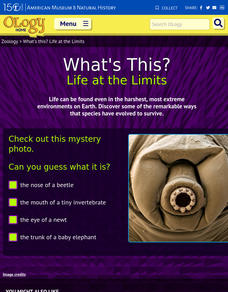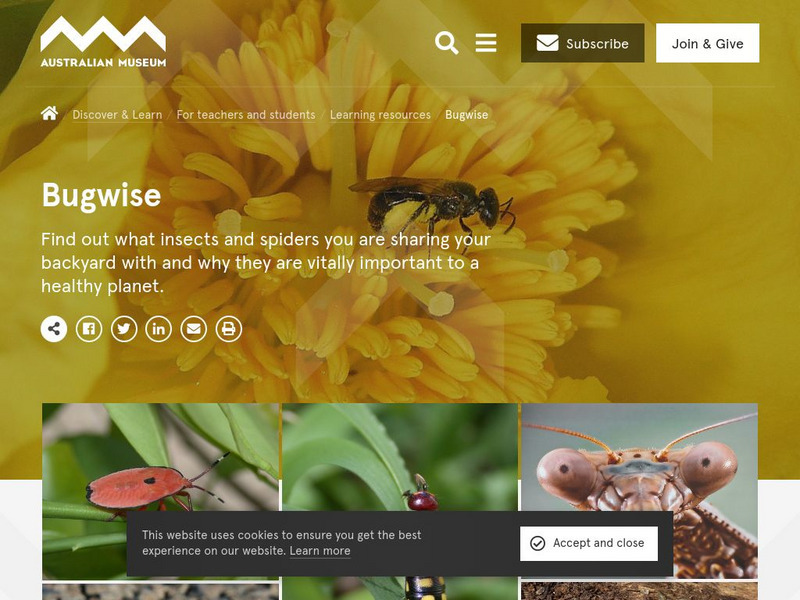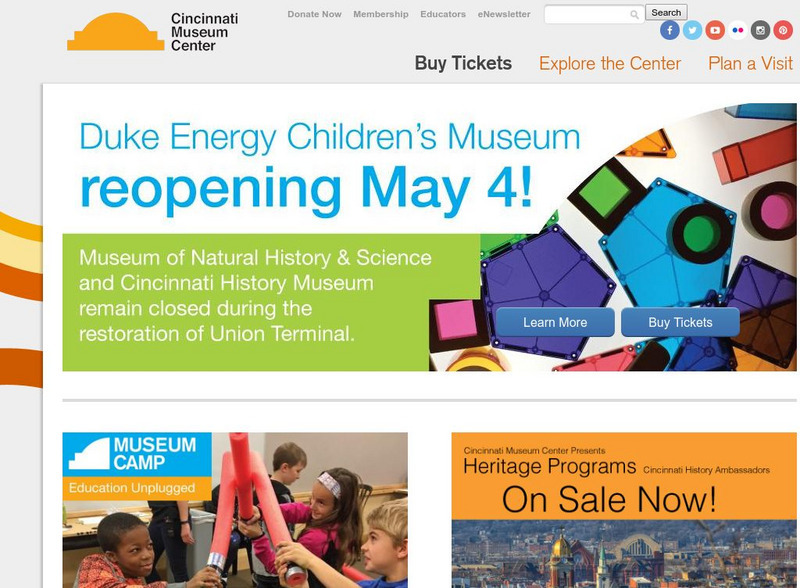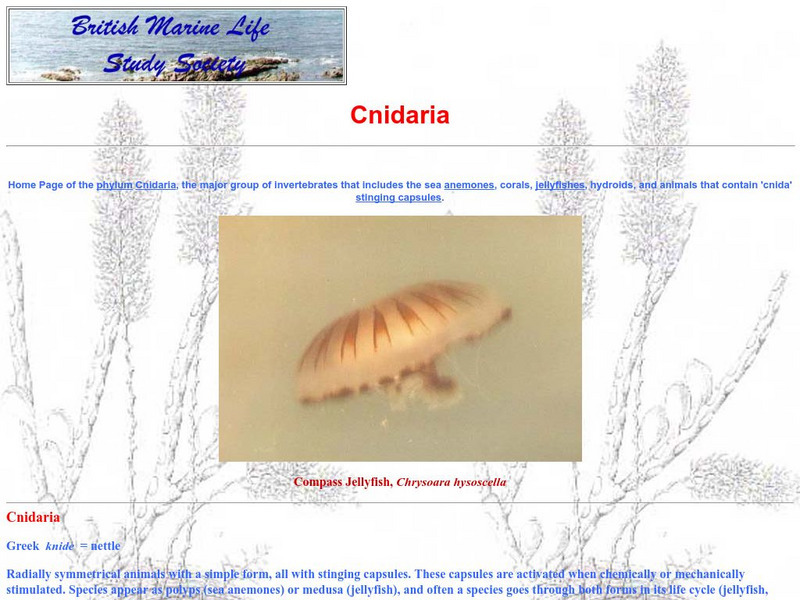American Museum of Natural History
The Tree of Life
Groups of species can have more in common than meets the eye. An interactive cladogram shows some of the connections between important groups of species. Learners click on sections of the diagram to learn more about the connections or on...
American Museum of Natural History
What's This? Life at the Limits
There are some amazing ways species evolve to survive. From large ears to sneezing salt, learners read about these interesting adaptations in an interactive lesson. Great to supplement an in-class lesson, it also works well as a remote...
American Museum of Natural History
What's This? Leeches
Who actually likes leeches? Meet a scientist that makes his living letting leeches feed on him. Pupils learn about the characteristics of leeches and different variations of the species. The lesson works as a remote learning resource or...
Smithsonian Institution
National Museum of Natural History: Department of Invertebrate Zoology
Search the Invertebrate Zoology Collection, and read about original research performed on all 30 major invertebrate animal phyla except insects.
Untamed Science
Untamed Science: Biodiversity: Animals: Invertebrates
See all the of the different animal phyla that represent invertebrates and how diverse they are with the help of short video clips.
Smithsonian Institution
National Museum of Natural History: Invertebrate Zoology Collections Search
A searchable database of the collections of invertebrates at the National Museum of Natural History. You can search by keyword, or in a more scientific way, such as by phylum or expedition.
Natural History Museum
Natural History Museum: Other Invertebrates
This online exhibit from the Natural History Museum studies a range of topics related to invertebrates, or animals without a backbone. Crabs, snails, barnacles, sponges, and more are discussed at this exhibit.
Environmental Education for Kids
Eek!: Other Invertebrates
Learn about various species of invertebrates including ticks, mussels, spiders and worms.
NOAA
Noaa: Living Ocean Gallery Invertebrates
Many still photographs and video clips of marine invertebrates are available in this huge collection.
Ducksters
Ducksters: Animals for Kids: Invertebrates
What is an Invertebrate? Kids learn about these animals that have no backbone such as worms, mollusks, insects, and spiders.
Smithsonian Institution
Smithsonian National Zoo: Zoogoer Magazine: The Marvelous Majority
This article examines a range of invertebrates. Among the invertebrates discussed included are jellyfish, coral, termites, gypsy moths, octopus, crayfish, and more.
Australian Museum
Australian Museum: Bug Wise
Explore the diverse world of invertebrates. Learn what they are, what they do, and how they contribute to our planet. This site offers "BugWise News", a forum, an invertebrate guide, and a wide range of great resources and activities.
Other
The Bug Club: Bug Pets
The Bug Club for young entomologists offers answers to insect questions, a colorful newspaper, and invertebrate caresheets if you're interested in keeping bugs as pets.
Other
Florida Department of Environmental Protection: Life in a Spring
Learn all about the diverse species that live in the Florida Springs. Separate sections for fish, reptiles and amphibians, birds and mammals, insects and invertebrates, and plants.
Other
Denver Museum of Nature and Science: Follow a Fossil
Students examine paleontology, the study of ancient life on Earth. Some topics explored are vertebrates, invertebrates, and plants.
Smithsonian Institution
National Museum of Natural History: Ocean Planet: In Search of Giant Squid
An on-line exhibit archived from a Smithsonian exhibit explores and interprets the facts and myths surrounding giant squids - the world's largest invertebrates.
Yale University
Yale Peabody Museum
This home page describes what the museum has to offer. Links to the exhibits and more information is provided at the bottom of the site.
Environmental Education for Kids
Eek!: Environmental Education for Kids
This site provides illustrations, descriptions, and species of amphibians, birds, fish, insects, invertebrates, mammals, reptiles, and endangered species.
Other
Cincinnati Museum Center
This site describes the Museum of Natural History and Science in detail and provides links to other programs and exhibits offered.
Other
Glaucus: Cnidaria
This is the home page of the phylum Cnidaria. Links to resources to the major group of invertebrates that includes the sea anemones, corals, jellyfishes, hydroids, and animals that contain 'cnida' stinging capsules.
Other
Black Hills Institute of Geological Research, Inc.: Ammonoids
Ammonoids, more commonly referred to as Ammonites, are the extinct ancestors of today's octopus, squid and nautilus. This page provides excellent information about these creatures, as well as diagrams and pictures.
PBS
Pbs: The Shape of Life
Companion site for the 8-part PBS series, "The Shape of Life." Each section focuses on a different phylum, from porifera through chordata. This site is highly informative, with beautiful photography.
Cornell University
Cornell University: Cornell Composting: The Science and Engineering Composting Composting
This clickable web page is like an outline that comprehensively covers the science of composting. Each link takes you to another section of notes.
Missouri Botanical Garden
Missouri Botanical Garden: Temperate Oceans
This site from the Missouri Botanical Garden is a comprehensive site covering various topics related to temperate oceans. Be sure to check out the ocean animals link on the left side to learn more about the invertebrates that live in the...
Other popular searches
- Invertebrates and Vertebrates
- Marine Invertebrates
- Invertebrate Worksheets
- Invertebrates Vertebrates
- Vertebrates an Invertebrates
- Vertebrate and Invertebrates
- Benthic Invertebrates
- Invertebrates Research
- Invertebrates + Vertebrates
- Invertebrate Phylum
- Invertebrate Classification
- Invertebrate Sponge


















